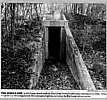Los Angeles Times
- Dec. 13, 2015 -Charles Carter writes
"The same story ran Nov. 29 in the Sun-Sentinel
in Palm Beach and Ft Lauderdale"
Cold War military base fills with new wildlife
BY DAVID FLESHLER
 KEY LARGO, Fla. -- An
eerie postapocalyptic landscape of abandoned bunkers,
collapsed guardhouses and rusted industrial debris
stretches across a Key Largo wildlife refuge, where the
work of protecting endangered species takes place
amid the ruins of a Cold War military base.
KEY LARGO, Fla. -- An
eerie postapocalyptic landscape of abandoned bunkers,
collapsed guardhouses and rusted industrial debris
stretches across a Key Largo wildlife refuge, where the
work of protecting endangered species takes place
amid the ruins of a Cold War military base.
The Crocodile Lake National Wildlife Refuge stands on a former Nike Hercules antiaircraft missile base, where launch crews stood ready to fire nuclear-armed missiles at Soviet bombers approaching Florida,
Today, with the Cold War over and the missile base closed for more than 30 years, the 6,700-acre site is devoted to the more peaceful purpose of providing a haven for endangered and threatened animals, such as the Key Largo woodrat, Key Largo cotton mouse, American crocodile and Schaus swallowtail butterfly.
"We're trying to restore this to tropical hardwood hammock, which benefits all the species here in Key Largo."
- JEREMY DIXON,
Crocodile Lake National Wildlife Refuge manager
But ruins of the base remain, and the refuge is attempting the difficult, time consuming job of getting rid of them.
Recently workers completed one removal job, taking out the missile assembly building, generator sheds and water tanks. More work will be undertaken as funding becomes available in a process likely to last for years as the refuge attempts to make it easier for nature to reclaim what's left of the old missile base.
"We're trying to restore this to tropical hardwood hammock, which benefits all the species here in Key Largo," ''said Jeremy Dixon, the biologist who serves as the refuge's manager. "This has been a slow work in progress. It's amazing how it's recovered on its own. Sometimes it needs some help, though."
On a walk along an overgrown, Army-built road, relics of the refuge's military past come into view through the tangle of poisonwood, Jamaican dogwood, gumbo limbo and other trees, a mix of vegetation more reminiscent of Caribbean islands than mainland Florida.
Kennels for the guard dogs can be seen through the trees. A pile of concrete rubble and cracked walls marks the site of a guard house, with red-and-black striped barrels filled with concrete and sand still standing as barriers.
Perhaps the strangest ruins are the three bunkers constructed under protective mounds of earth to shield the missile crews. A walk into one of them, through an inch-thick metal door that hangs crookedly from its hinges and down a corridor lined with peeling paint of pale blue and yellow, reveals a dark, cramped, cobweb-filled interior.
Although the bunkers are likely to remain, since they would be too expensive to remove, nature has begun asserting itself. An enormous strangler fig tree has spread its roots around the entrance to one bunker, gripping it in an embrace that will only grow tighter with time.
The contrasts are striking between the land's military past and its current purpose, In a field next to the Army road stand dozens of foot-high pink flags, marking spots where volunteers planted torchwood plants, which serve as hosts for the endangered Schaus swallowtail butterfly. The field used to be the site of the missile warehouse.
"It's a surreal moment when you realize you're planting these plants for an endangered species on what used to be a nuclear site," Dixon said.
The U.S. Fish and Wildlife Service, while assessing the effect of the most recent removal project, said an important reason for getting rid of the ruins was their potential for harboring damaging non-native species, such as the black rat and Burmese python, a species best known for colonizing the Everglades.
The Nike base on Key Largo, known as B Battery, became operational in 1965 as one of four Nike bases constructed in South Florida after the Cuban missile crisis.
At Crocodile Lake, the removal work likely will focus next on the base's old sewage treatment plant, which has open water pits that could be a hazard to wildlife. But none of the work is likely to erase the site's past.
"We don't think this is ever going to be completely gone," Dixon said. "It's always going to be in the shadow of what used to be here."
dfleshler@tribpub.com